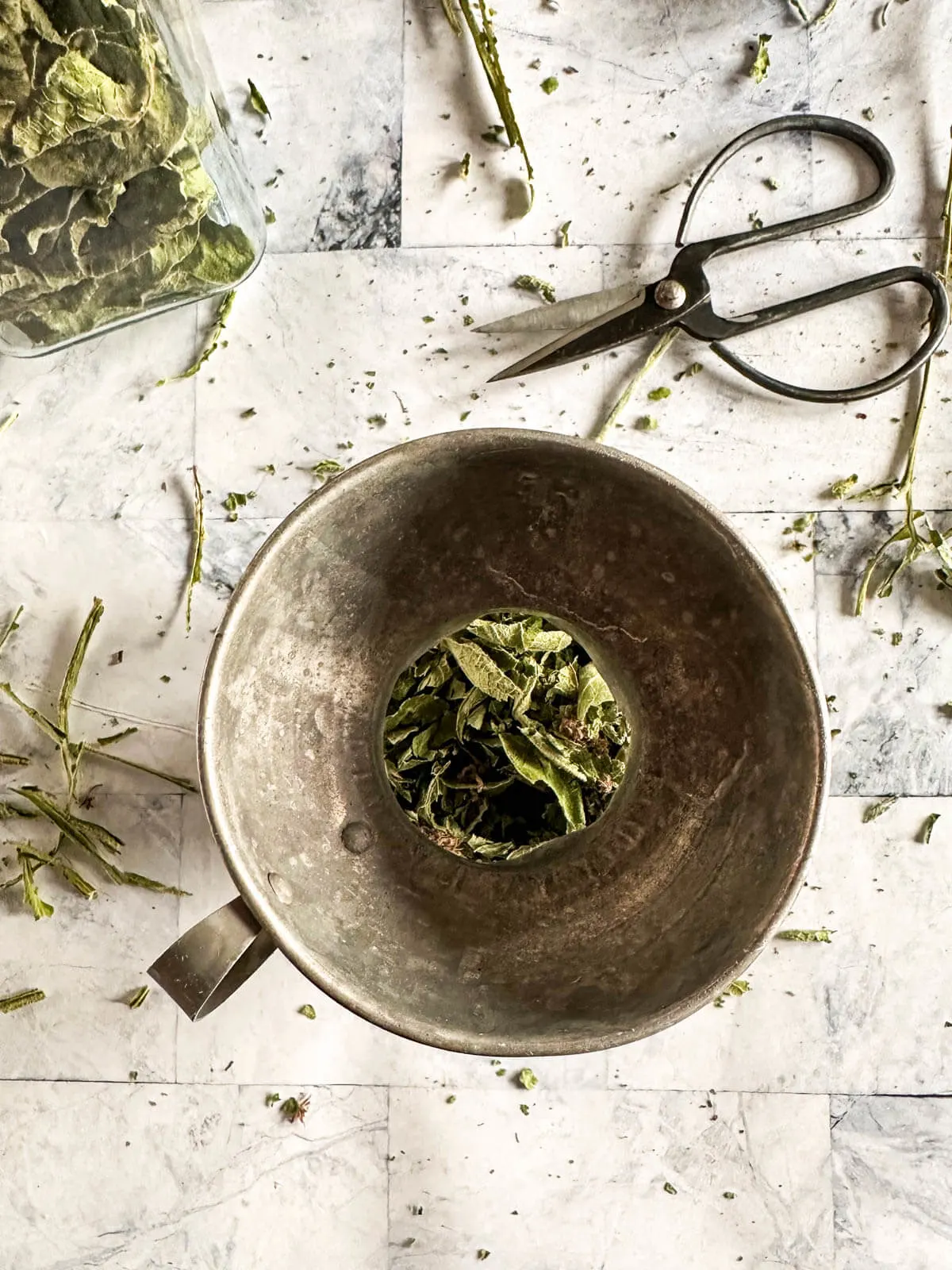Now that you've planted root cuttings, waited the entire season, and harvested comfrey leaves, it's time to dry them!
The drying process is essential as it not only preserves your harvest for future use but also concentrates the beneficial compounds found in comfrey leaves. Whether you're planning to use them for a homemade salve or a nutrient-rich plant feed, properly dried leaves are key.

As an Amazon Associate I earn from qualifying purchases.
Jump to:
What Is Comfrey?
Comfrey (Symphytum spp.) is a cold hardy perennial herb native to Europe and parts of Asia. It's been introduced in North America as an ornamental. It's known for its beautiful bell-shaped flowers that can range in color from cream, pink, and blue to purplish-blue, depending on the variety.
The plant typically grows between 2 to 5 feet tall, and it has hairy and angular stems. The leaves are large and broad at the base, getting smaller as they go up the stem. They are usually dark green on the top and lighter underneath, with a rough, hairy texture.
Comfrey is also recognized for its thick root. This root system is vigorous and allows the plant to thrive in a wide range of soil types, although it prefers rich, moist soil. It also allows the plant to reproduce via root cuttings and crown divisions.
One of the most notable characteristics of comfrey is its use in herbal medicine. The plant has been used in traditional medicine since at least the 16th century, particularly for its ability to heal wounds and broken bones. However, it's important to note that oral consumption is generally not recommended due to the presence of certain toxic compounds that can affect the liver over time.
Comfrey is also often used in organic gardening and permaculture practices as it is believed to be a dynamic accumulator. Its leaves are a rich source of nutrients and can be used to make an excellent fertilizer and additions to the compost pile.
Many people practice chop and drop mulching which is a lot like comfrey compost, allowing the leaves to decompose in place around the plants in their food forests and forest gardens to return the nutrients to the surface level for use by microbes in the soil. While others use the large leaves to make comfrey tea fertilizers to feed plants liquid nutrients.

Comfrey Safety
No matter the herbal benefits of comfrey, it should NOT be ingested. It contains pyrrolizidine alkaloids which can cause liver toxicity and that is the absolute opposite of what we want as people who turn to natural healing. Use caution and research before using comfrey in your own home.

Harvesting Comfrey
Once the plant reaches 2 feet tall, snip large leaves near the base of the plant, leaving smaller furled leaves intact for the plant to continue photosynthesizing.
Comfrey should be harvested in early - mid September, before the first hard frost 28F or -3C.
Related: How To Harvest Comfrey Leaves

How To Dry Comfrey Leaves
There are 2 easy ways to dry comfrey leaves, one uses a dehydrator and one uses air circulation. Both have their merits.
Air drying is quite easy, and requires only space and some airflow. Air drying takes a lot longer, but also doesn't consume any power, making it an environmentally friendly option.
Using a dehydrator speeds up the process drastically, but it requires specialized equipment and consumes electricity.

Drying Comfrey Leaves In A Dehydrator
The fastest way to dry comfrey leaves is by tearing the leaves from the stem and laying them flat in a single layer on the rack of your dehydrator, I love using my 9 Tray Excalibur Dehydrator for herbs like comfrey. By removing the stems from the leaves, the drying time becomes more predictable and prevents over drying of the leaves while the succulent stems retain moisture.
Dry the leaves at the lowest temperature setting for about 8 hours. You'll know the leaves are done drying when they are brittle and crumble easily.

Air Drying Comfrey Leaves
This low-tech method is a great way to dry the leaves, though the better the airflow, the quicker the leaves will dry.
We used a string and needle and threaded each comfrey leaf through the stem, then looped the thread around the stem to 'lock it into place', aiming to separate the leaves by at least 8 inches.
Then we got creative and started hanging the threads anywhere with good airflow, including the garage door rails, the sides on my plant stand, and even the shower rod in the garage bathroom.
Alternatively, you can thread the fresh leaves on a string and hang like bunting.
We allowed the leaves to dry for 4-6 days, or until they are dry and brittle.


Storing Dried Comfrey Leaves
Leaves can be left whole or crushed before placing in jars. Large leaves are better suited to compresses and poultices, while ground leaves are better for infused oils and salves.
Store your dried leaves in tightly sealed glass jars or other air-tight containers in a cool, dark space, away from direct sunlight until you're ready to use them.
When properly stored, the leaves should last at least 1 year, but should be used sooner than later for the highest quality.

Using Dried Comfrey
Dried comfrey has many herbal uses;
- poultices
- salves
- lotions
- infused oils
Notes From The Homestead Garden
These nutrient-dense leaves can be used in creating infused oils, lotions, salves, and poultices, comfrey offers natural solutions for sustainable living.
However, it's important to acknowledge and respect its potential health risks, particularly its liver toxicity when ingested. With the right knowledge and precautions, comfrey can serve as a valuable resource in our gardens and homes.
Pin This Guide To Drying Comfrey Leaves

